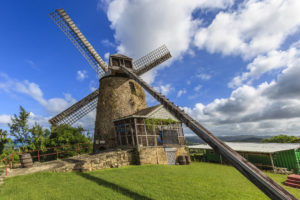The Lewis branch of our family spent a generation on Barbados and likely owned a windmill. The island’s settlers traded extensively with the Netherlands, and Dutch influence can be felt there to this day.
History Of Barbados

Amerindians inhabited Barbados in the pre-Columbian era, but the Spanish enslaved and removed all of the natives in the 1500s. Thus, when the English first landed in Barbados in 1624, they found a tropical paradise with fertile soil, ideal weather, and no native population to inhibit colonization.
In 1627, when English planters established the first permanent settlement on the leeward coast of Barbados, tobacco was the most profitable cash crop in Europe. News of this beautiful island spread quickly in England, inciting “tobacco fever.” Immigration to Barbados was so rapid that Barbadians exported 100,000 pounds of tobacco back to England in 1628, just one year after tobacco was first planted on the island. At some point, enslaved Africans replaced English indentured farm workers, and Barbados developed one of the cruelest cultural structures in the new world.
Profits from tobacco were enormous but short-lived. By 1631, the London tobacco market was glutted with imports from Virginia and the West Indies, and prices dropped dramatically. Virginians wielded considerable diplomatic power in London, and they convinced King Charles I to issue an imperial order to limit tobacco production in the Caribbean.
Some planters in Barbados switched to growing cotton, which was profitable for most of the 1630s. However, once again high profits drove overproduction, leading to a glut of cotton and declining prices. Gradually, Barbadians turned to the crop that would change the destiny of their island—sugar.
But they would need help from an outside source that arrived due to a civil war in Brazil.
Introduction Of Sugar Production In Barbados
Brazil was the world’s main sugar producer in the 1630s. The colony was populated mainly by immigrants from Portugal, but Dutch overseers and merchants dominated the sugar industry. In the 1640s the Portuguese revolted and expelled the Dutch, leading to a dramatic drop in Brazilian sugar production.
Dutch merchants turned to Barbados to continue their profitable involvement in sugar production and shipping. The Dutch provided Barbadians with agricultural advice, sugar processing machinery, shipping, financing, and credit.
They also brought their windmill technology to provide the energy necessary to process raw sugar cane. Typically, each sugar farm had its own processing building and its own windmill. Within a short time, Barbados had the second-highest number of windmills per square mile in the world, second only to Holland.
Our Family’s Arrival To Barbados
Sometime before 1663, Hugh Lewis left his home in cold, rainy Wales to start a new life on the beautiful Caribbean island of Barbados—a relatively new English settlement that was thriving economically. In fact, during the 17th century, the economic output of Barbados exceeded that of all of the American colonies and Jamaica combined.
Hugh and Margaret’s daughter Elizabeth Lewis (1665-1702) married 2 years later.
Hugh Lewis first appears in Barbados records in 1663. He married Margaret Dallathy 2 years later. The family is listed on the 1679 Barbados census living in St. James Parish on the leeward side of the island. Hugh Lewis held the rank of Captain in the Barbados Militia, which was determined solely by wealth. There were no British regular troops posted to Barbados, because of the lack of hostile threats, so the militia was important as the island’s law enforcement force.
Hugh and Margaret’s daughter Elizabeth was married twice. Her first husband died in 1687, soon after their marriage, possibly from one of the epidemics that periodically swept the island.
Hugh Lewis died in 1689. In 1692, a particularly severe epidemic killed so many men that ships sat idle in the harbor for months for want of crewmen.
The Move to Virgina
Sometime in the 1690s, Elizabeth and her mother left Barbados for Virginia, where Elizabeth married the next in our ancestral line, Abraham Venable III. There was considerable movement of English settlers among the New World colonies. It was not uncommon for colonists to flee the strict religious culture of New England by relocating to Barbados. Conversely, many English emigrants settled first in Barbados before moving to Virginia or other American colonies. However, the details of Margaret and Elizabeth’s move to Virginia, and how they came to know the Venables, are unknown, and are subjects for future research.
The last working windmill on Barbados was the Morgan Lewis windmill that continued in operation until 1947. We don’t know if Morgan Lewis was a member of our Lewis family–another topic for future research.
© 2013 W. Mullins
